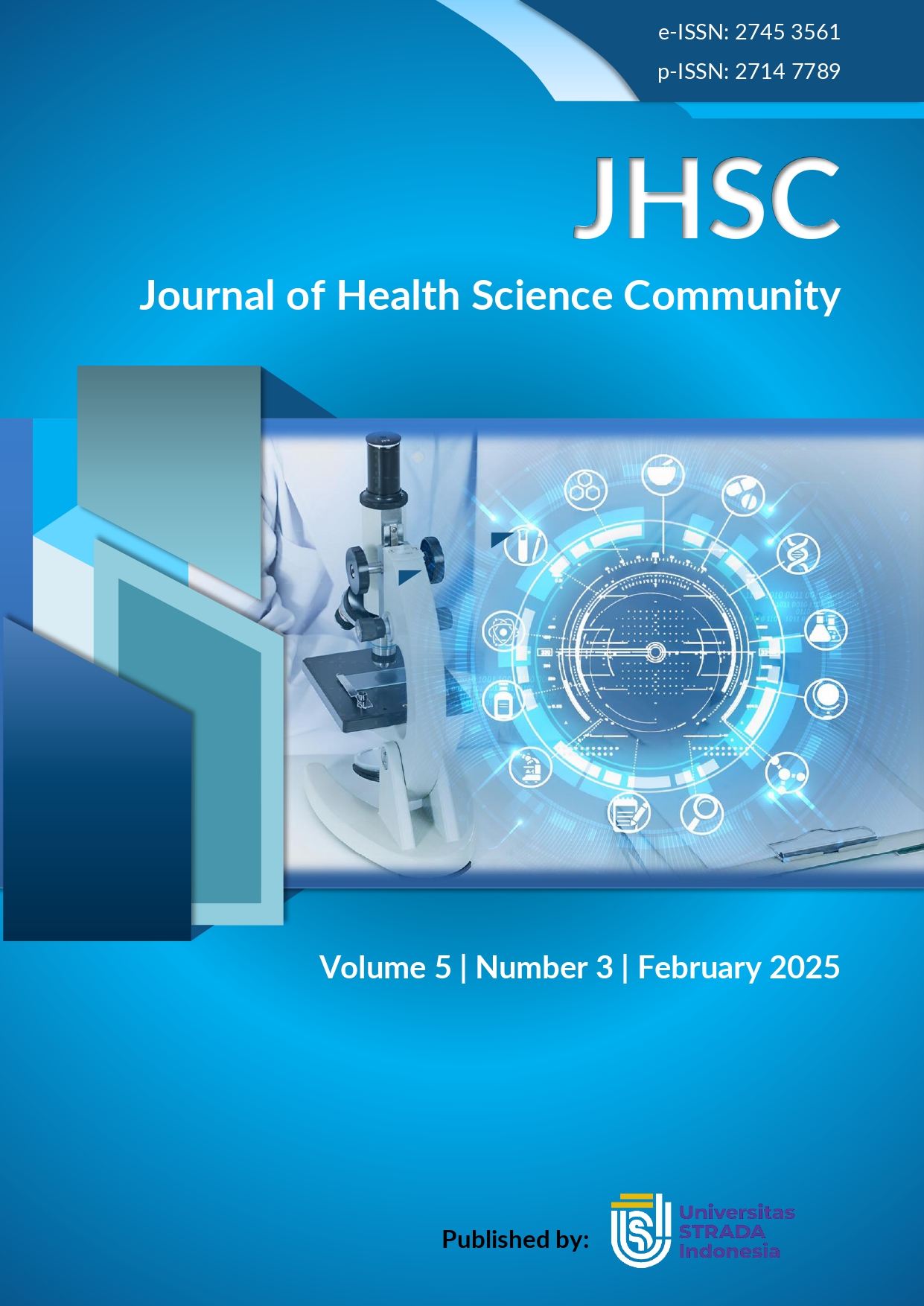Providing Exclusive Asi To Working Mothers Reviewed From Motivational Factors And Length Of Parental Leave At Pt. Rhs Seruyan District Central Kalimantan
DOI:
https://doi.org/10.30994/jhsc.v5i3.266Keywords:
Exclusive Breastfeeding, Working Mother, Motivation, Maternity LeaveAbstract
Exclusive breastfeeding is very important for the growth and development of babies. A mother's motivation is crucial in providing exclusive breastfeeding for six months. Apart from that, working mothers can be affected by insufficient time for maternity and maternity leave. The aim of this research is to determine the relationship between exclusive breastfeeding for working mothers in terms of motivation factors and length of maternity leave at PT.RHS, East Seruyan Regency, Central Kalimantan. The design of this research is observational analytics with a cross-sectional time approach. The sample in this study was 32 mothers who had babies aged > 6 months at PT.RHS East Seruyan Regency, Central Kalimantan. The sampling method used a simple random sampling technique. Data collection uses a questionnaire. Data analysis used the chi square statistical test. The research results showed that of the 32 respondents, the majority did not provide exclusive breastfeeding, 20 people (62.5%), the majority with low motivation, 18 people (56.3%), and most of them took the appropriate length of maternity leave (3 months). before giving birth 1.5 months and after giving birth 1.5 months, namely 17 people (53.1%).Data analysis using statistical tests with Chi Square shows that the significance level is 0.000 < α = 0.05 so that H0 is rejected and H1 is accepted, thus there is a relationship between exclusive breastfeeding for working mothers in terms of motivation factors and length of maternity leave at PT.RHS, Seruyan Regency. East, Central Kalimantan. Meanwhile, the results of the logistic regression test showed a relationship between motivation and length of maternity leave with exclusive breastfeeding at PT.RHS, Seruyan Regency, Central Kalimantan. The motivation variable has a stronger relationship with exclusive breastfeeding with an OR value of 24.686 compared to the length of maternity leave variable with an OR value of 16.941. It was concluded that the success factor in providing exclusive breastfeeding was low motivation and insufficient maternity and maternity leave. So it is necessary to strengthen the motivation of breastfeeding mothers so they can provide exclusive breast milk.
References
Desi Purnamasari, 2019. Thesis on Factors Associated with the Failure of Exclusive Breastfeeding in the Working Area of the Pakualaman Community Health Center, Yogyakarta City.
Jessica Novia, 2020. The Influence of Length of Maternity Leave on the Continuity of Breastfeeding. Scientific Writing Report. Ministry of Health. 2019. Reducing Child Mortality Rates Goal 4: Reducing Child Mortality Rates, 51–56.
Indonesian Ministry of Health. (2021). Indonesian Health Profile. Indonesian Health (2020). https://doi.org/351.077 Eng Man-Ku, C., & Chow, S. K. Y. (2014). Factors Influencing the Practice of Exclusive Breastfeeding Among Hong Kong Chinese Women: A Questionnaire Survey. Journal of Clinical Nursing, 19, 2434–2445.
Maya Cobalt, et al. (2020). The Influence of Peer Education on Self-Efficacy and Motivation of Breastfeeding Mothers in Providing Breast Milk. Journal of Community Nursing Science Volume 2 No 1, Pages 26 - 32, May 2020.
Mubarak, W., I. & C. (2019). Introduction to Community Nursing Science and Theory. Jakarta: Salemba Medika.
Ni Putu Ayutia Sri Wahyuni, (2022). Thesis on the Relationship between Mother's Employment Status and Motivation for Providing Exclusive Breast Milk in the Abiansemal I Community Health Center Work Area, Badung Regency.
Ni Made N. Padmasari S, et al. (2020). The Relationship between Mother's Employment Status and Motivation for Providing Exclusive Breast Milk in the Working Area of Mengwi Iii Health Center, Badung Regency.
Community of Publishing in Nursing (COPING), Volume 8, Number 3, Pages: 305 – 311, October 2020.
Notoatmodjo, S. (2020). Health Education and Behavior. Jakarta: Rhineka Cipta.
Nurhidayati, et al. (2022). The Relationship between Mother's Employment Status and Exclusive Breastfeeding in Blang Asan Village, Peusangan District, Bireuen Regency.
Muslim Health Journal, Vol.Vii No.1 April 2021 Okawary O, Purwati Y, (2019). Thesis on the Relationship between Mother's Employment Status and Exclusive Breastfeeding in the Seyegan Health Center Working Area, Sleman Yogyakarta.
Central Kalimantan Provincial Health Service Profile, 2021. Exclusive breastfeeding coverage profile.
Central Kalimantan. Kotawaringin District Health Service Profile, 2021. Exclusive breastfeeding coverage profile. Kotawaringin, Central Kalimantan.
Rochjati. (2019). Antenatal Screening in Pregnant Women. FK Unair. Spaulding, D. M. Breastfeeding self-efficacy in women of African descent. Proquest.
Sarah Fadhilla Maulida Bakri, et al. (2021). Factors influencing exclusive breastfeeding for babies in Daulat Village, Langsa Kota District. MIRACLE JOURNAL E-ISSN 2774 – 4663 Vol 2, No 1, Page: 178-192, January 2022.
Maramis F, Tumurang M, Kalesaran A 2020. The Role of Health Promotion Officers, Maternal Knowledge and Family Support in Increasing Exclusive Breastfeeding in the Airmadidi Health Center Working Area, North Minahasa Regency.
Suyami. (2021). The influence of education about exclusive breastfeeding on the level of maternal self-efficacy for breastfeeding low birth weight babies, 05.
Utami, N T; Abdullah, T; Sarake, M. (2020). Factors Associated with Exclusive Breastfeeding in the Working Area of the Birobuli Health Center. Faculty of Public Health, Hasanuddin University.
UNICEF Indonesia. 2021. Breast milk is the cheapest and most effective life saver in the world. In; UNICEF Indonesia.
Uyun, Z. (2020). The Relationship Between Mother's Knowledge About Exclusive Breastfeeding and Motivation for Exclusive Breastfeeding. Muhammadiyah Surakarta university.
Wulan S, Dewi R., 2019. The Effect of Long Working Hours for Working Mothers on Exclusive Breastfeeding. Bimtas Journal Volume: 5, Number 1. 2019. Wiji, R. N. (2020).
Breast Milk and Breastfeeding Mother's Guide. Yogyakarta: Nuha Medika. Yulianti, F. (2019).
The Relationship Between Characteristics, Level of Knowledge and Family Support for Exclusive Breastfeeding in the Working Area of the Siantan Hulu Community Health Center, North Pontianak District, 2019.
Zahro, W., Pangestuti, D. R., & Widajanti, L. (2020). Patterns of Giving Breast Milk (ASI) and Nutritional Status of Breastfeeding Mothers in the Working Area of the Kedungmundu Community Health Center, Semarang City. PUBLIC HEALTH JOURNAL, 4(3), 272–281. https://doi.org/23563346


















